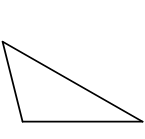Terms
In order to understand the section, we must first understand the plane. A plane is a surface such that if any two points on the surface are connected by a line, all points of the line are also on the surface.
If points, lines, segments, and so forth lie in the same plane, they are coplanar. In the same way, if any of these do not lie in the same plane, they are noncoplanar.
Another term we need to be familiar with is transversal. A transversal is a line that intersects two coplanar lines in two distinct points.
In the diagram below, line n is the transversal. The region above line t and below line m is the exterior of the figure. The region between lines A and B is the interior of the figure.
Lines and Transversals create angle pairs. These angle pairs include: Corresponding Angles, Alternate Interior Angles, and Alternate Exterior Angles.
· Corresponding Angles are a pair of angles formed by two lines and a transversal. One angle must lie in the interior of the figure and the other must lie in the exterior. The angles must lie on the same side of the transversal but have different vertices. Angle 1 and Angle 5 in the diagram above are examples of corresponding angles.
· Alternate Interior Angles are a pair of angles formed by two lines and a transversal. Both angles must lie in the interior of the figure, must lie on alternate sides of the transversal and have different vertices. Angle 4 and Angle 6 in the diagram above are examples of alternate interior angles.
· Alternate Exterior Angles are a pair of angles formed by two lines and a transversal. Both angles must lie in the exterior of the figure, must lie on alternate sides of the transversal, and have different vertices. Angle 2 and Angle 8 in the diagram above are an example of alternate exterior angles.
That should get us started on transversals and angle pairs,
thank you,
Ryan















